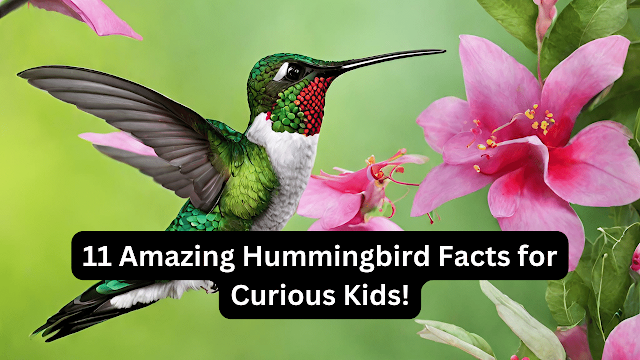11 Amazing Hummingbird Facts for Curious Kids!
Hummingbirds are tiny marvels, and these 11 Amazing Hummingbird Facts for Curious
Kids! Learn about their incredible flight, dazzling colors, and surprising
secrets. Kids of all ages will be buzzing with excitement!
Introduction:
11 Amazing Hummingbird Facts for Curious Kids!
Have you ever seen a hummingbird flit from flower to
flower, a tiny jewel of feathers with wings that blur like a miniature
helicopter? These feathered acrobats are more than just pretty faces – they're
packed with fascinating facts that will make you say "Wow!" So buckle
up, curious minds, as we dive into the world of hummingbirds and discover 11 Amazing Hummingbird Facts for Curious
Kids!
11 Amazing
Hummingbird Facts for Curious Kids!
1. Tiny Titans of
Flight
- The World's
Smallest Birds: Hummingbirds are the tiniest birds in the world, some
weighing as little as a penny! The Bee Hummingbird, the smallest of them all,
is about the size of a bumblebee.
2. Masters of the
Air
- Super-Fast Wings: Hummingbirds'
wings beat incredibly fast, up to 75 times per second, creating the humming
sound they're named for. This allows them to hover mid-air, fly backward, and
even zip around like miniature fighter jets.
- Aerial Acrobats: Unlike other
birds, hummingbirds can rotate their wings at the shoulder joint, giving them
unparalleled maneuverability. They can fly sideways, upside down, and even
perform tight figure-eight loops!
3. Jewels in the
Garden
- Rainbow Feathers: Hummingbirds are
adorned with stunning iridescent feathers that shimmer with vibrant colors like
ruby red, emerald green, and sapphire blue. These colors shift depending on the
light, making them look like living jewels.
- Flower Power: Hummingbirds rely
on flowers for their sweet nectar, which fuels their high-energy lifestyle.
They have long, slender beaks and forked tongues perfectly adapted for reaching
deep into blossoms to sip nectar.
4. More Than Just
Pretty Feathers
- Big Brains: Don't let their minor
mass fool you! Hummingbirds have the largest brain-to-body ratio of any bird,
meaning they're incredibly intelligent and quick learners. They can remember
the location and blooming times of hundreds of flowers!
- Fierce Defenders: Despite their tiny
size, hummingbirds are surprisingly territorial. They'll chase away much larger
birds to protect their feeding grounds, buzzing and flashing their feathers
like feathered feisty fighters!
5. Fun Facts for
Curious Minds
- Hummingbird
Hearts: A hummingbird's heart beats up to 1,200 times per
minute, the fastest of any animal! This incredible metabolic rate allows them
to stay active and constantly on the move.
- Egg-cellent
Architects: Hummingbird nests are tiny marvels of engineering,
built with moss, spider silk, and even lichen. They're often camouflaged within
leaves and branches, keeping their precious eggs safe and sound.
- Migration Marvels: Some hummingbird
species migrate thousands of miles each year, traveling long distances from
their wintering grounds to their summer breeding grounds. These tiny travelers
can fly across oceans and mountains, guided by an internal compass and fueled
by their love of flowers!
Conclusion:
Hummingbirds are more than just beautiful birds –
they're living examples of nature's incredible engineering and resilience.
Their tiny size, dazzling colors, and remarkable flight abilities make them a
wonder to behold. So the next time you see a hummingbird flitting by, remember
these amazing facts and appreciate these feathered jewels for the true
treasures they are!
Recommendations:
- Plant a hummingbird garden with bright, tubular flowers to attract these feathered visitors.
- Hang a hummingbird feeder to provide a reliable source of nectar, especially during migration periods.
- Observe hummingbirds gently and learn about their behavior. You might even discover new and fascinating facts!
FAQs:
Q: Why do
hummingbirds hum?
A: The humming sound is produced by the rapid beating
of their wings.
Q: Can
hummingbirds fly backward?
A: Yes, they're the only birds that can!
Q: What do
hummingbirds eat besides nectar?
A: They also eat small insects, spiders, and even
pollen.
Additional Tips
and Tricks:
- Create hummingbird-friendly nesting sites by providing hanging baskets or sheltered corners in your garden.
- Minimize the use of pesticides to protect the hummingbird's food source and avoid harming these delicate creatures.
- Share your knowledge and appreciation for hummingbirds with others – help spread the wonder and inspire conservation efforts!
